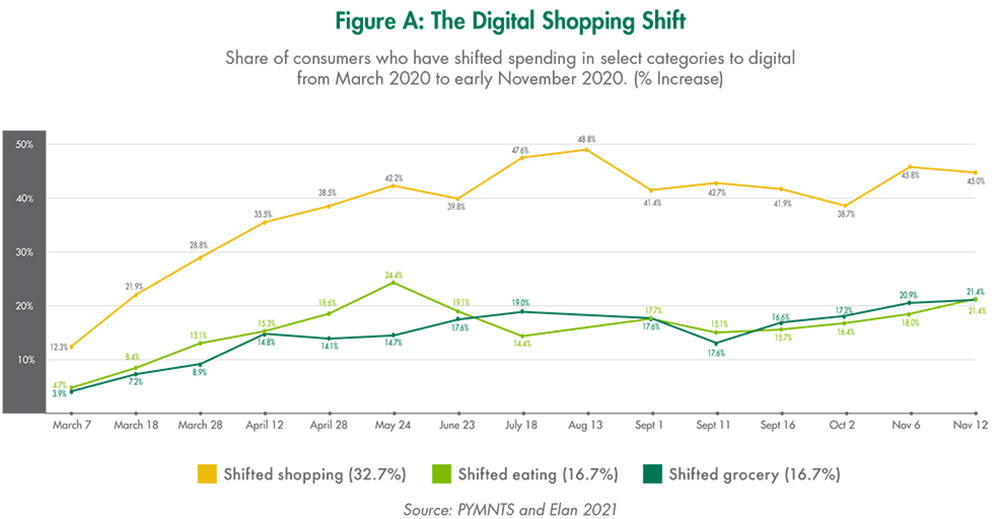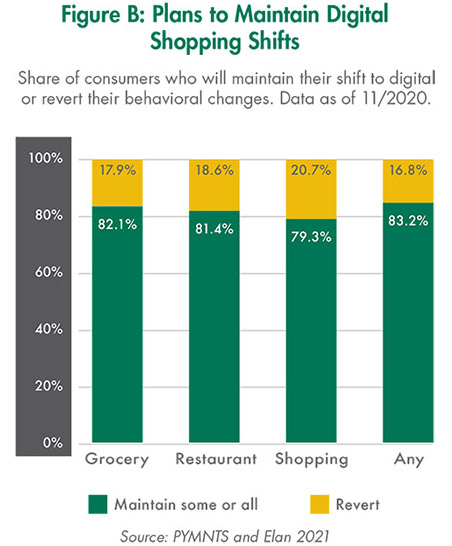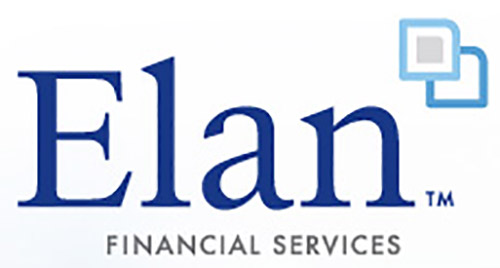
3 trends shaping the credit card industry
Adjust your approach to remain relevant to cardmembers.
Three new trends are shaping the credit card industry in this time of rapid change. Credit unions looking to offer a competitive credit card program should be aware of these trends and implement adjustments to remain relevant to cardmembers.
1. Increasing need for enhanced digital capabilities
The events of 2020 greatly accelerated the rate at which the digital transformation occurred. Activities and processes transitioned out of necessity and, in some cases, overnight.
As consumers quarantined, online shopping experienced a rapid shift to online channels. A recent report, “Online Security and The Debit-Credit Divide,” by Elan and PYMNTS, found that 45% of consumers transitioned to digital shopping channels to purchase retail products, a fourfold increase since the start of the pandemic.
Figure A details the increase in retail, along with two other main spending categories: groceries (17%) and restaurants (13.3%). Both groceries and restaurant purchases were on a steady incline to a peak of 21% by mid-November.

The findings from the Elan and PYMNTS report discovered that consumers plan to maintain their digital shopping habits going forward. In Figure B, 82.1% of grocery spenders indicated they would stick with digital channels, followed by spending at restaurants at 81.4% and retail shopping at 79.3%.

Consumers also changed their payment methods. When online purchases increased, 41% of consumers reported a preference to pay with credit cards versus 35% opting to use debit and 15% preferring digital wallets.
Credit unions must build robust security features and fraud detection tactics into the central infrastructures of their credit card programs.
More than half of Americans report they are now using some form of contactless payment, such as digital wallets and contactless card technology.
These technologies allow consumers to pay by hovering their phone or card over the payment terminal while their card information is passed to the terminal via near-field communication (NFC) technology. The use of contactless payments exploded exponentially in 2020 as consumers sought protection from possible transmission of the coronavirus.
Credit unions must offer contactless payment options to cardmembers or risk losing members to credit card programs with more robust digital offerings.
2. Changing rewards environment
The pandemic upended credit card rewards. Rewards shifted to everyday essentials such as groceries, food delivery, and streaming services, which consumed increasingly larger proportions of consumers’ monthly spending.
Credit card products focused on travel reevaluated rewards options to provide more flexibility. Some issuers allowed cardmembers to redeem travel points for nontravel purchases at the same value per point, while others launched products that provided cash back on pandemic-friendly spending categories.
Credit unions offering credit cards must keep up with shifting rewards trends. Credit unions should offer a full suite of rewards products to reach the entire scope of membership.
3. Uncertain future credit environment
Americans paid off a record $83 billion of credit card debt in 2020. This is likely due to federal relief through the receipt of stimulus checks and other government assistance and extended forbearance programs from issuers. However, this situation is not expected to last. With spending predicted to surge in 2021 as more consumers become fully vaccinated and the nation continues to open more fully, the timeline for charge-off (the amount of defaulted credit card balances) recognition has extended beyond initial predictions and is now expected to manifest in the second half of 2021.
Credit unions may be experiencing low losses and delinquency rates. They should consider this to be temporary as there is a predicted influx in consumer spending and expiration of federal benefits and forbearance programs. Credit unions should be mindful of the potential for varying levels of losses because they can affect the overall profitability of credit card programs.
Elan is committed to staying competitive
Having a partner like Elan provides the opportunity to stay competitive and follow market trends.
Elan has enhanced digital tools, launched new card products, and increased frictionless access to applications for new members. Elan also invested in new servicing capabilities, fraud detection enhancements, and text to apply.
Elan’s robust suite of credit cards offers competitive rewards at no cost to credit unions and includes options such as cash back on frequently used and pandemic-friendly spend categories.
Learn more and read the full whitepaper “Three Trends That Are Shaping the Credit Card Industry.”
CHRIS DRAACK is national sales director at Elan Financial Services.
About Elan Financial Services
For over 50 years, Elan has offered an outsourced partnership solution, providing credit unions the ability to offer a competitive credit card program. Visit cupartnership.com.
